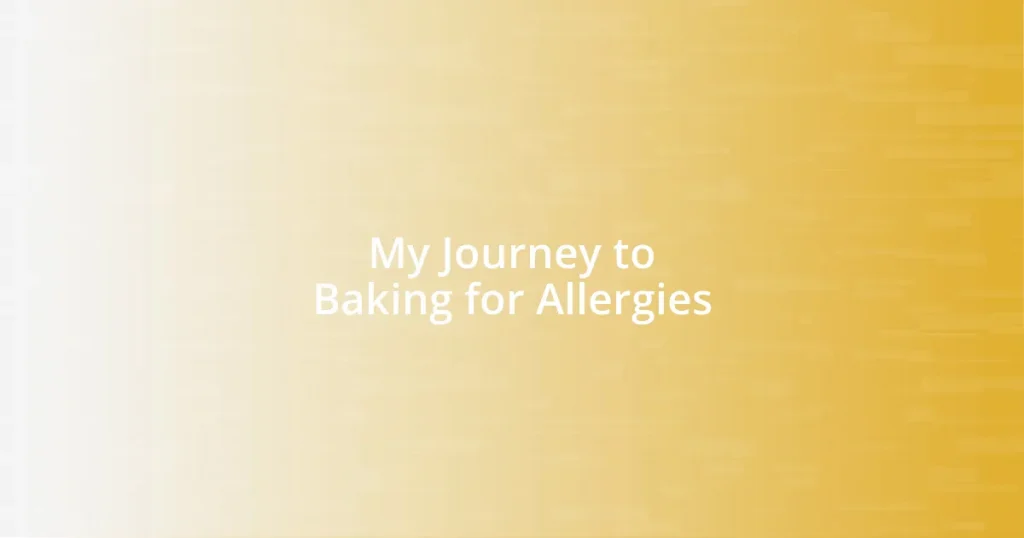Key takeaways:
- Food allergies require constant vigilance and awareness, as reactions can vary significantly among individuals.
- Understanding safe ingredient alternatives and using substitution guides can enhance baking creativity and safety.
- Documenting baking experiments and adjustments helps refine recipes and avoids past mistakes.
- Sharing experiences through social media and blogging fosters a sense of community and provides support for those navigating food allergies.
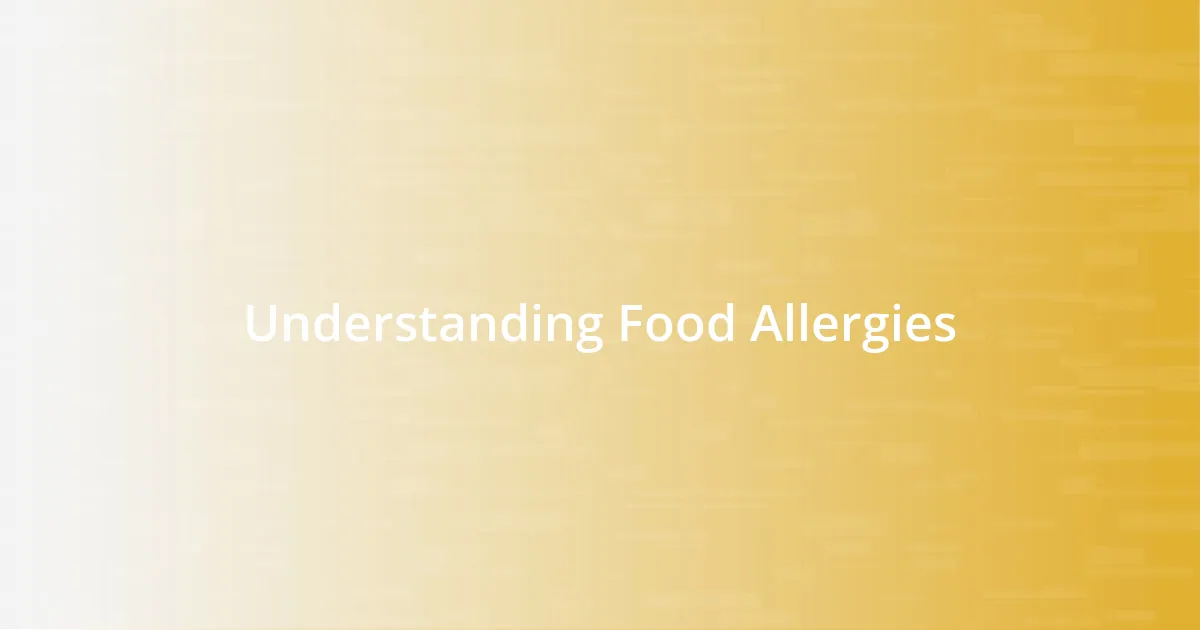
Understanding Food Allergies
Food allergies occur when the immune system mistakenly identifies a harmless substance, like certain foods, as a threat, leading to various uncomfortable reactions. I remember the first time I encountered someone with a severe allergy; it was eye-opening to see how a simple snack could become a significant danger. Have you ever thought about how pervasive these allergens can be in our daily lives?
There are common allergens such as peanuts, tree nuts, dairy, and gluten that affect millions, but I find it fascinating how each person’s reaction can differ immensely. For instance, while my friend has a mild reaction to shellfish, another acquaintance experiences life-threatening symptoms with the same food. This makes understanding individual allergies crucial; everyone’s body has its own unique way of responding.
Navigating a world filled with allergens requires constant vigilance, and it can be quite an emotional rollercoaster. I often wonder how many people truly realize the impact it has on those living with allergies—it’s not just about avoiding certain foods; it’s about safety, comfort, and a constant need for awareness. Doesn’t it make you appreciate the complexity and challenges faced by those who must tread carefully in their food choices?
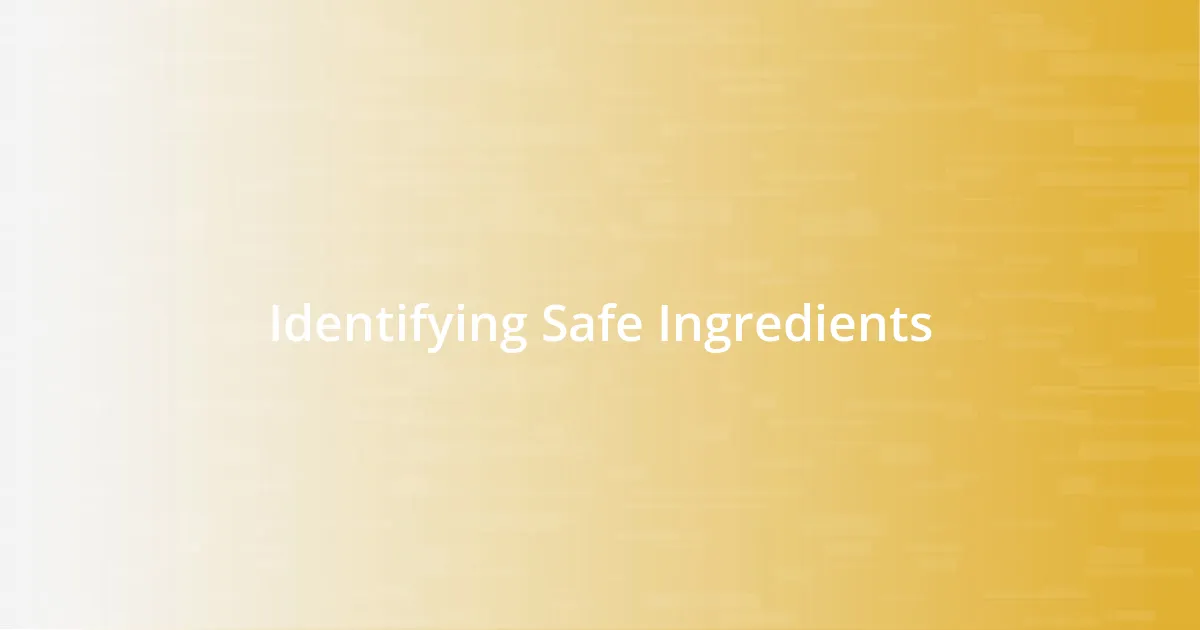
Identifying Safe Ingredients
Identifying safe ingredients is a fundamental step on my journey to baking for allergies. When I began, I often felt overwhelmed by the multitude of labels and dietary terms. I learned that reading ingredient labels meticulously is crucial; I have found that even trace amounts of a less obvious allergen can pose serious risks. Have you ever checked a label only to find “may contain traces of”? It’s often enough to make you rethink your choices entirely.
As I’ve gained experience, I’ve come to appreciate the inherent differences between brands and products. For example, certain brands of almond milk may process their products in shared facilities with nut-containing items, while others are certified allergen-free. It becomes an ongoing puzzle to identify which ingredients are truly safe! I recall a time when I accidentally grabbed a brand of vegan chocolate chips, thinking they were safe, only to later discover they contained hidden milk derivatives. It was a humbling reminder to double-check everything.
Using an allergy-friendly substitution guide has also been a game-changer for me. These guides provide fantastic alternatives that not only meet safety requirements but also maintain the flavor and texture I love in baked goods. My first attempt using aquafaba instead of eggs yielded such fluffy cookies that I couldn’t believe they were allergy-safe! It’s moments like these that make the journey truly rewarding, reaffirming my commitment to exploring safe ingredients.
| Ingredient Type | Safe Alternatives |
|---|---|
| Dairy | Coconut milk, almond milk |
| Wheat (Gluten) | Rice flour, almond flour |
| Eggs | Flaxseed meal, aquafaba |
| Peanuts | Sunflower seed butter |
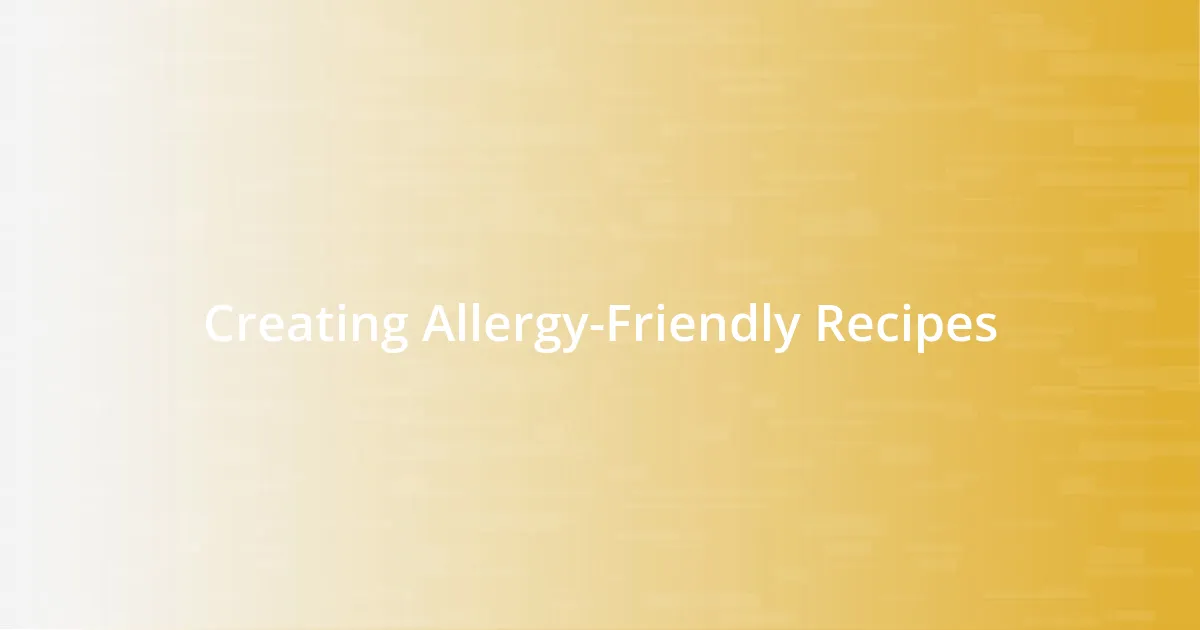
Creating Allergy-Friendly Recipes
Creating allergy-friendly recipes is both an art and a science. I often find it incredibly rewarding to take a traditional recipe and transform it into something safe for everyone. Just the other day, I decided to experiment with a family favorite chocolate chip cookie recipe. To make it allergy-friendly, I switched out the butter for coconut oil and replaced flour with a blend of oat and almond flour. The resulting cookies were not only delicious but also a testament to the idea that fun flavors can come from simple, thoughtful changes.
To further streamline the process, I’ve developed a few go-to techniques that help when crafting new recipes:
- Explore Different Flours: Using a variety of gluten-free flours, like coconut or chickpea flour, can yield different textures and flavors.
- Use Natural Sweeteners: I’ve found that maple syrup or mashed bananas can add sweetness without triggering allergies.
- Flavor Enhancers: A splash of vanilla extract or a sprinkle of cinnamon can elevate taste without including allergens.
- Texture Alternatives: For creaminess, I often blend soaked cashews or use silken tofu, which works wonders in smoothies and desserts.
These little tweaks have not only made my recipes safe, but they’ve also opened up a world of flavors that I never thought possible in allergy-friendly baking. It’s a journey of discovery where I’ve learned to embrace creativity alongside caution.
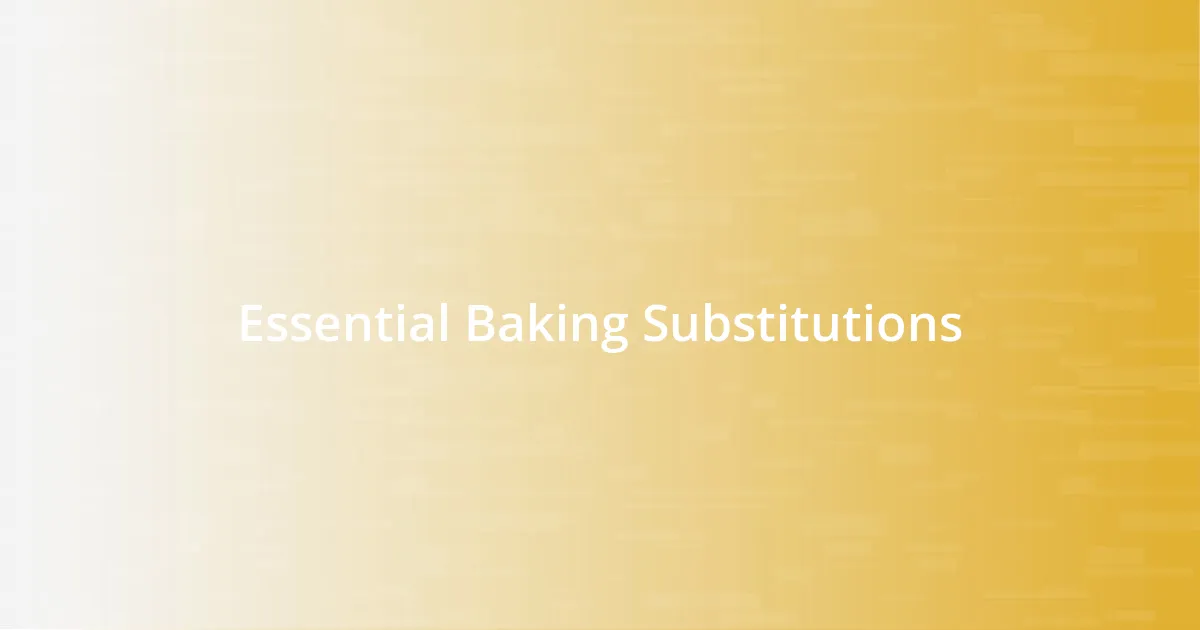
Essential Baking Substitutions
When diving into the world of baking substitutions, it’s easy to feel a bit lost at first. I remember my initial attempts to swap out common ingredients; I was nervous! Substituting traditional flour with almond flour was a revelation. I was surprised to find that not only did it work beautifully in muffins, but it also added a lovely nutty flavor that I simply adored. Have you ever tried a new ingredient only to discover it becomes a new favorite?
Another essential substitution for me has been using applesauce in place of eggs. The first time I made this swap, I was skeptical. Would my homemade brownies hold together? To my delight, they came out moist and rich, with none of the usual egginess. And the best part? I felt good knowing my baking was a bit healthier. It’s moments like these that remind me — sometimes, experimentation leads to unexpected triumphs.
I also rely heavily on natural sweeteners, like maple syrup and agave nectar, instead of refined sugars, especially since I’ve noticed how much they enhance flavor without bringing in common allergens. One afternoon, I decided to bake a carrot cake using mashed bananas instead of sugar. The result? A moist, naturally sweet cake that disappeared in minutes. Wouldn’t you agree that discovering these alternatives feels like uncovering little treasures in your pantry? Each substitution unlocks new potential in our baking adventures.
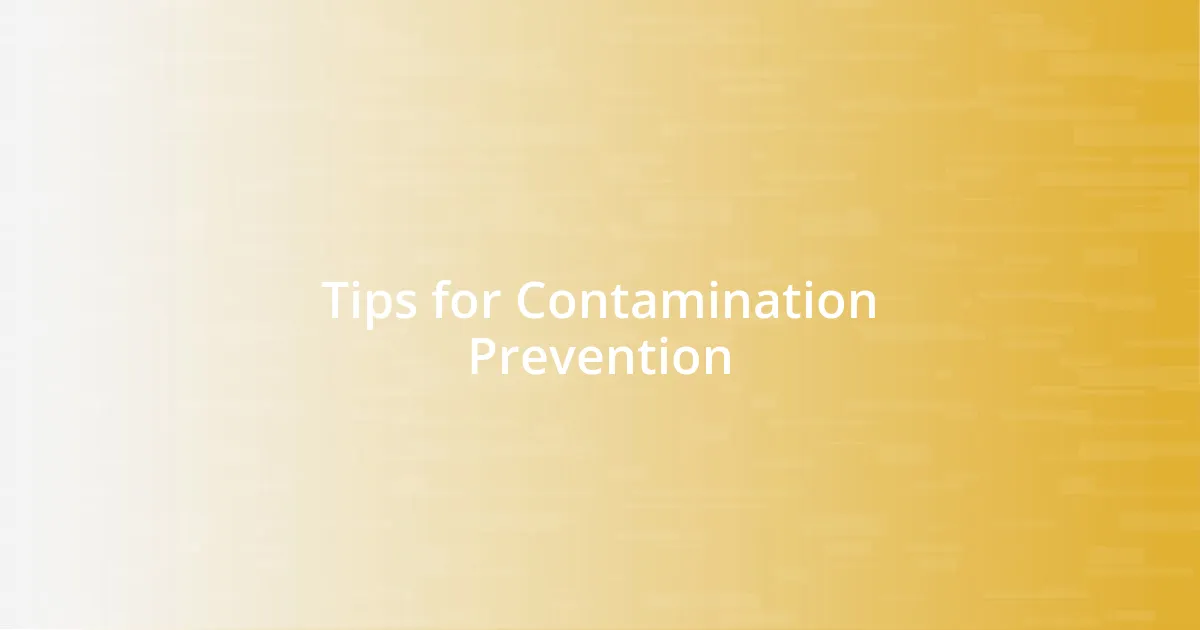
Tips for Contamination Prevention
When it comes to preventing contamination during baking, I’ve found that cleanliness is truly key. After a particularly chaotic baking session where I accidentally mixed flour from a regular bag with my gluten-free stash, I quickly learned the importance of using separate utensils and mixing bowls for allergen-free recipes. I now designate specific tools solely for allergy-friendly baking, ensuring that there’s no chance of cross-contact.
One practical tip I swear by is washing everything thoroughly before I start. I keep a bottle of allergen-free dish soap handy, and I’m meticulous about cleaning countertops and surfaces I’ll be working on. The first time I saw how much flour dust could linger on my kitchen counters, I was shocked! Just imagine mixing up a batter only to find traces of what you were trying to avoid. Wouldn’t that dampen the joy of baking? By taking that extra moment to clean, I create a safe space to whip up my favorite treats without the worry.
Lastly, I advocate for using clear labeling for all my ingredients. There’s nothing worse than reaching for a container and second-guessing what’s inside. As someone who’s had my fair share of kitchen mix-ups, I can’t stress enough how labeling has saved me from accidentally introducing allergens. I remember a time when I nearly grabbed a bag of regular flour without double-checking—such a small mistake could lead to significant consequences. This simple step brings peace of mind, allowing me to focus on creating delicious, safe recipes instead of stressing over hidden ingredients.
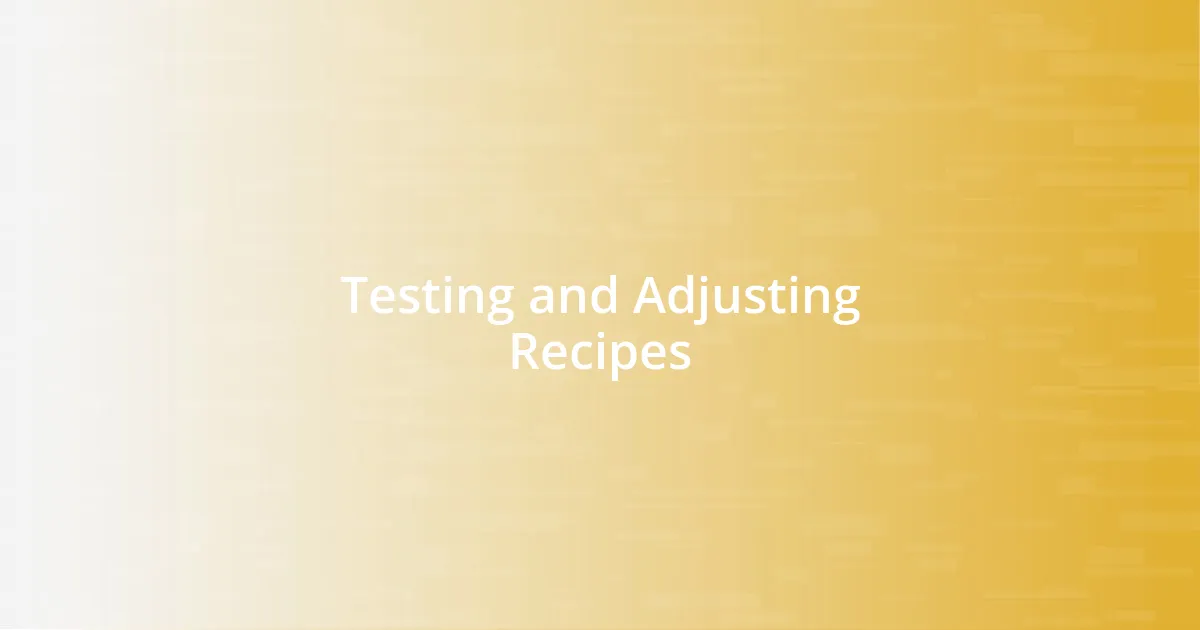
Testing and Adjusting Recipes
Testing and adjusting recipes can feel like an adventure, especially when you’re accommodating allergies. I vividly recall the first time I attempted to bake gluten-free cookies. The initial batch was a total flop—too crumbly and dry! Through trial and error, I learned that adjusting the ratio of almond flour to coconut flour made all the difference. Isn’t it fascinating how a simple tweak can transform your baked goods?
I often find that flavor balancing is just as crucial as ingredient adjustments. During my attempts to create a nut-free cake that still packed a punch, I experimented with adding a touch of citrus zest. The bright flavor elevated the cake, making it more enjoyable for my friends who usually shy away from allergen-friendly treats. Have you ever altered a recipe and been surprised by how much a small addition can enhance your baking?
Finally, I highly recommend keeping detailed notes throughout the process. Remember that time I forgot what I did differently with a batch of muffins that turned out perfectly? I ended up on a quest to replicate that success and learned the hard way to document my adjustments. I now cherish those notes—it allows me to revisit the successes and avoid past mistakes! It’s amazing how personalizing your baking journey can inspire not only you, but also those around you to explore allergen-friendly delights.

Sharing Your Allergy-Friendly Journey
Sharing my allergy-friendly journey has been one of the most rewarding experiences in my baking life. When I first started, I felt isolated in my kitchen, hesitant to share my creations with friends. It wasn’t until I hosted a small gathering, armed with allergy-friendly desserts, that I realized how much people appreciated these efforts. Their surprised and delighted reactions reminded me why I embarked on this path in the first place—baking can be inclusive and delicious, no matter the restrictions.
I often find that social media has become an incredible platform for sharing this journey. I remember posting a photo of my dairy-free chocolate cake, and the flood of comments from people expressing their own allergy stories was heartwarming. It’s like starting a conversation that connects us all—an unspoken bond over our challenges and triumphs in the kitchen. Have you ever felt a sense of community by sharing your own culinary ups and downs? It’s a reminder that we’re all in this together, learning from one another and celebrating every small victory.
Moreover, I keep a blog to document my recipes and experiences—it’s my way of contributing to others who might be struggling. One particular entry about overcoming my fear of baking with unusual ingredients really struck a chord with my readers. The feedback I received was immensely encouraging, reinforcing the idea that sharing my journey not only helps me grow but inspires others to take their first steps in allergy-friendly baking. Isn’t it fascinating how a simple recipe can spark a journey of discovery for everyone involved?










